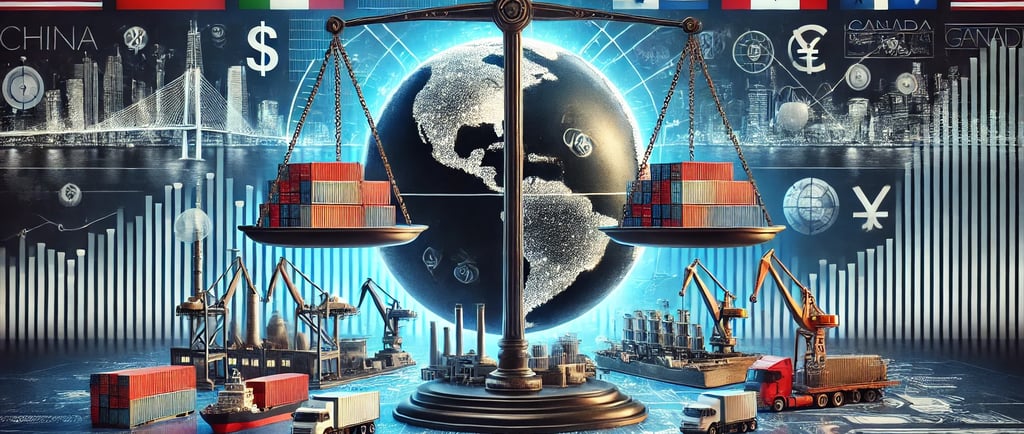Proactive Risk Management: A Case Study on Navigating Tariffs in Organizations
Case Study: Proactive Risk Management in organizations due to Tariffs.
RISK MANAGEMENT
Jeffrey McDaniels - Supply Chain Management Educator, APICS Fellow & Master Instructor, SCM Content Developer
1/29/20252 min read


Case Study: Proactive Risk Management in Organizations Due to Tariffs
Background
A global electronics manufacturer, TechWorld Inc., relied heavily on sourcing components from various countries, including China. With the introduction of the U.S.-China trade tariffs, which imposed a 25% duty on specific electronics components, TechWorld Inc. faced rising costs, supply chain disruptions, and increased uncertainty in production planning.
The Problem
The company initially absorbed some tariff costs but soon realized this was unsustainable. Without a proactive risk management approach, TechWorld Inc. risked losing its competitive pricing advantage, straining supplier relationships, and delaying product launches due to supply chain bottlenecks.
Key challenges included:
Rising Costs: Tariffs increased the costs of imported components by millions annually.
Supply Chain Disruptions: Delays in customs clearance and increased documentation requirements.
Operational Uncertainty: Difficulty forecasting future impacts of fluctuating tariff policies.
Limited Alternatives: Over-reliance on Chinese suppliers with few viable alternatives.
Proactive Risk Management Approach
TechWorld Inc. adopted a proactive risk management strategy to mitigate tariff-related risks while maintaining operational continuity. Here’s how they approached it:
1. Risk Identification and Assessment
The company conducted a comprehensive risk assessment using the following steps:
Mapping the Supply Chain: Identified all suppliers impacted by tariffs and categorized them by criticality to production.
Cost Impact Analysis: Quantified the financial burden of tariffs across product categories.
Scenario Planning: Evaluated multiple "what-if" scenarios to determine potential tariff policy changes and their impact.
2. Diversifying the Supply Base
To reduce dependency on tariff-heavy regions, TechWorld Inc. implemented a dual-sourcing strategy:
Nearshoring: Shifted 30% of production to Mexico, leveraging USMCA trade benefits.
Regional Suppliers: Partnered with Southeast Asian suppliers in countries like Vietnam and Malaysia, offering competitive pricing without tariffs.
3. Redesigning the Supply Chain
The company restructured its supply chain to improve resilience:
Component Localization: Collaborated with U.S.-based manufacturers to produce critical components domestically, qualifying for tariff exemptions.
Alternative Materials: Worked with engineering teams to redesign products using tariff-free substitute materials.
4. Strengthening Supplier Relationships
TechWorld Inc. worked closely with existing suppliers to share the tariff burden:
Collaborative Cost Management: Negotiated long-term contracts with shared risk provisions to stabilize costs.
Supplier Development Programs: Provided training and financial support to diversify their suppliers' production bases.
5. Leveraging Technology for Visibility
The company implemented advanced analytics tools to monitor global trade regulations and tariffs in real-time:
Digital Twin Technology: Simulated supply chain changes to evaluate cost and lead time impacts.
Trade Compliance Systems: Automated tariff classification and ensured compliance with new policies.
Results
After implementing its proactive risk management strategy, TechWorld Inc. achieved significant improvements:
Cost Savings: Reduced annual tariff-related costs by 40% through supplier diversification and cost-sharing agreements.
Supply Chain Resilience: Increased on-time delivery performance by 20% despite global disruptions.
Operational Flexibility: Reduced lead times by 15% due to nearshoring and regional sourcing.
Strategic Agility: Positioned itself to quickly adapt to future trade policy changes, gaining a competitive advantage.
Key Takeaways
Diversification is Key: A diversified supply chain mitigates risks and provides greater flexibility to adapt to external challenges like tariffs.
Collaboration Drives Success: Strong supplier partnerships and co-investment in solutions create win-win outcomes.
Data-Driven Decisions: Leveraging technology for real-time visibility and predictive modeling enhances risk management capabilities.
Resilience is Proactive: Organizations that proactively address supply chain risks can navigate disruptions more effectively and maintain competitive advantage.
Application for Training
For mid-level supply chain professionals:
Scenario Analysis: Learn how to simulate tariff changes' financial and operational impacts.
Supplier Collaboration Strategies: Practice negotiation techniques to share risks and costs with suppliers.
Technology Utilization: Understand how to use advanced tools to monitor and adapt to global trade changes.
